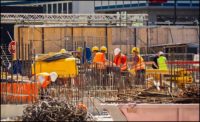While building resilience, and resilience in general, has been in the news, and these columns, over the past years, it’s also important to keep security in mind as part of the HVAC system design goals. In this month’s column, I will revisit some of the major concepts regarding building security as it relates to the building systems. When discussing design goals and preventive measures, remember that security does not only apply to criminal or terrorist activities but also to events, such as wildfires, accidental chemical spills/releases, etc.
The first concept I would like to explore is that the comfort and health of the building occupants must not be jeopardized when addressing security concerns. The preservation of the day-to-day operation of building systems to serve their intended functions, at the appropriate level, must not be compromised. Concerns about smoke or other infiltration due to an extreme event cannot lead to, for example, reduced airflows under typical operating conditions that negatively impact IAQ. Note that the reduced airflow may not manifest due to the design itself, but if the cost of running the equipment to maintain the flow rate is sufficiently high, the owner may reduce its use over time and, thus, negatively affect the air quality in the building.
Another security-related idea that is sometimes overlooked is compartmentalization. By that I mean evaluating different areas of the building, such as mail rooms or loading docks, as potentially requiring unique security solutions. By separating the systems in these areas from the remainder of the building, it is possible to meet the enhanced security goals without negatively impacting occupants. The separation may be as simple as different circuits/zones using the same equipment as the rest of the building, or it may require parallel systems where there is no connection to the main systems. This later solution may be particularly appropriate for areas intended for the building occupants to shelter in place for an extended period of time, or where the identified threats are significant enough to justify the costs.
Although it has almost become a cliché regarding HVAC security, proper placement of outdoor air intakes remains a basic first step in securing buildings. This is typically thought of in terms of physical security — locating intakes where there is no (or at least no easy) access to unauthorized personnel. While this is important, and should be part of every design, regardless of the risk analysis, it’s not the only consideration in outdoor air intake placement. Depending on the identified risks, there may be reasons to locate air intakes on one side of the building instead of another, or at a specific location on the roof. For example, if a chemical plant location and the prevailing winds suggest any leak is likely to result in the fumes impacting the north side of the building, it may make sense to locate the air intakes on the other faces. For larger projects, or those with a higher likelihood of risks, the use of a plume analysis to inform the intake locations may be appropriate.
A related issue is the building envelope design. It does not make sense to perform a plume analysis and appropriately locate the air intakes if the envelope is not airtight and will allow infiltration of exterior contaminants anyway. Thus, a proper envelope design, including appropriate air/moisture barriers and the ability to maintain positive pressure works hand in hand with the other security measures. Not properly accounting for the envelope performance can degrade the effectiveness of other security measures and may even negate their usefulness altogether.
The design concepts explored in this column are just the tip of the iceberg regarding security design for building systems. However, with the discussions about resilience and energy efficiency taking center stage in recent years, it’s still important for owners and designers to consider security issues and how security-related design decisions can impact other aspects of building operation.





